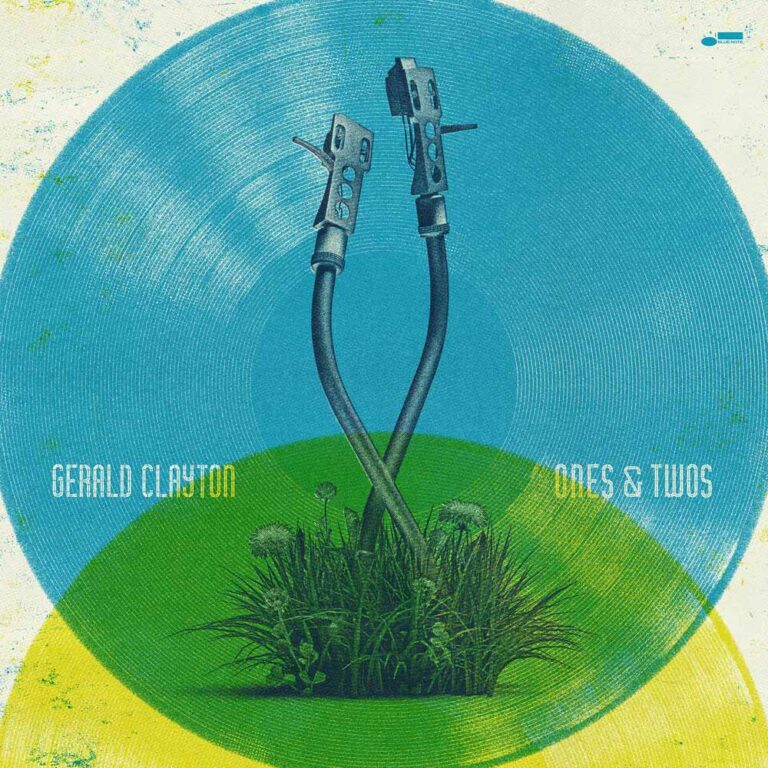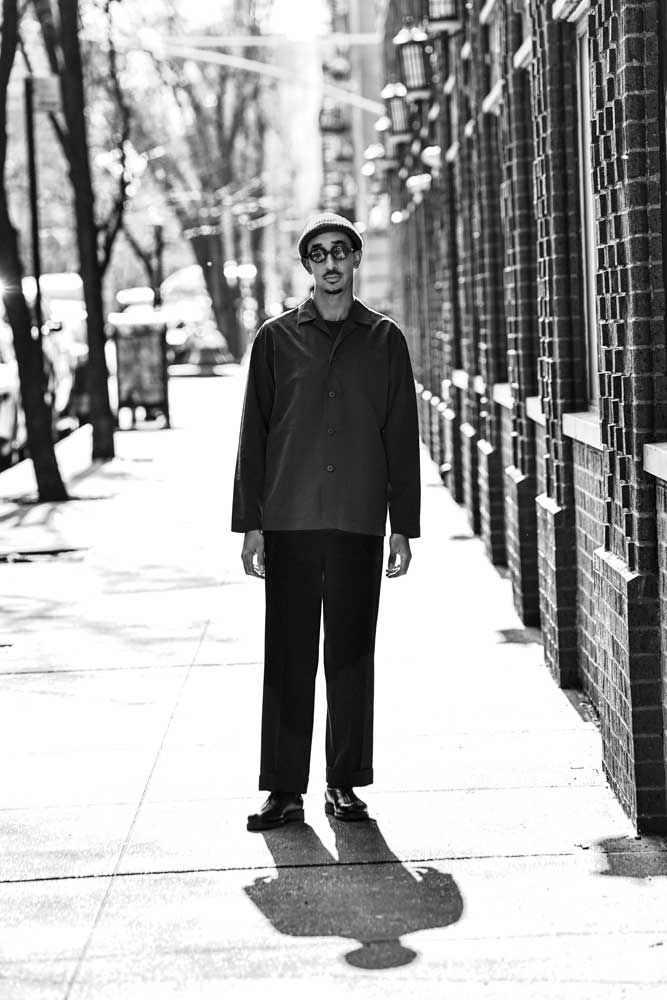“When I set out to play, I want to make sure that I’m serving the music,” says six-times Grammy-nominated pianist, composer and educator Gerald Clayton, sitting before a wall colonised by artwork at his home in Los Angeles. “That involves playing with truth and honesty, not letting any theory or premeditated thing lead the way. I enjoy the uncertainty of composing, the looking for something new and unprecedented.”
“Has this been done before? Maybe not literally,” he muses. “Ones & Twos”, Clayton’s third album for Blue Note, touches on the art of turntablism to explore ideas of duality and co-existence. Each track on Side A has a corresponding track on Side B. Each track is its own entity, on its own journey, with its own beauty, tension and sense of homecoming. But paired – or even played simultaneously – they weave through one other with organic flair, in ways not dissimilar to a club DJ overlapping the end of one song into the start of the next.
“But decisions that work in tandem happen all the time in jazz, which is downstream from the great sacred tradition of the blues, which at its essence is a testifying of our joys and sorrows and the source of everything,” he continues, flexing the sort of affable smarts he deploys in his roles as artist-in-residence at University of Southern California, director of the Monterey Jazz Festival Next Generation Jazz Orchestra and host of the Monterey-sponsored web series The Listening Space, a guide to diving deeper into jazz.

GERALD CLAYTON Ones & Twos
Available to purchase from our US store.The son of veteran bassist/composer John Clayton and nephew of late saxophonist Jeff Clayton, the Netherlands-born Gerald (whose classical pianist mother is Dutch) began gig-going with his parents when a toddler in Altadena, in the north of Los Angeles. He grew up surfing, skating, rapping, kicking footballs and “doing graffiti art in my notebooks, experimenting with turntables like every other ’90s hip hop kid in my class.” But always, there was piano.
As a student at the prestigious Los Angeles County High School for the Arts, Clayton’s sensitive, cerebral but rootsy aesthetic won him the 2002 Presidential Scholar of the Arts Award. He studied under piano icons Billy Childs (at USC) and Kenny Barron (at Manhattan School of Music) before releasing his 2009 debut “Two-Shade”, and was Grammy-nominated for Best Improvised Jazz Solo for his on-the-fly take on Cole Porter’s “All of You”, competing alongside heavyweights Terence Blanchard and Roy Hargrove, both of whom he would go on to work with (he’s currently part of SF Jazz’s Terence Blanchard’s UpSwing Series).
As a member, with his dad and uncle, of hard-bop unit The Clayton Brothers, he was Grammy-nominated again in 2010 for Best Instrumental Composition for “Battle Circle” from “The New Song and Dance”. Clayton Sr. remains his son’s biggest cheerleader.
“My father is excited that I’m doing stuff I love to do,” says Clayton of his Grammy-winning pater familias, formerly of Count Basie Orchestra and Monty Alexander Trio and a one-time principal bassist with the Amsterdam Philharmonic.
“You know, a lot of cats from older generations, whether it’s my dad or Charles Lloyd [the saxophonist, 87, has mentored Clayton since 2013] are way more open-minded than they’re given credit for and totally in support of this kind of searching. It’s important to remember that the spirit of the music is always freedom, always looking ahead.”

Both a skilled improviser and a visionary composer, Clayton is counted in the vanguard of the younger community of American musicians making jazz accessible to a new generation. As indeed are his collaborators on “Ones & Twos”, a bespoke, Blue Note-friendly quartet featuring vibraphonist Joel Ross, flautist Elena Pinderhughes, trumpeter Marquis Hill and drummer Kendrick Scott – oh, and with post-production by zeitgeist-lassoing rapper/drummer Kassa Overall.
“They’re all like-minded spirits, part of that family of hungry musicians on the scene right now who want to push themselves and instill life into the music, who are very rooted to the past while setting their aim forward,” says Clayton, who is the Musical Director for Out Of/Into, the all-star Blue Note collective (Ross, Scott, bassist Matt Brewer, alto player Immanuel Wilkins) that formed late last year to celebrate the label’s 85th anniversary.
“I knew that the sensibility I was going for with this record would resonate with them, that I could trust in their musicianship,” he continues, “and they delivered.”
He began, he says, by asking questions. Is it possible for two separate melodies to co-exist harmoniously? Does one melody inevitably dominate the other? As he did with the painterly “Bells On Sand” (2023), an exploration of the impact of time and his second album for Blue Note after “Happening: Live At The Village Vanguard” (2020), Clayton broadened the concept out. Is it possible for two people to co-exist without dominating one another? Two cultures?
“One of the lessons we may gain from the music is that there will be moments of friction/tension, and there will be moments where two things fit together smoothly/peacefully,” he states in the press release.
As he says now, “That blend of one song finishing in a club [on one turntable] and another starting [on another turntable]. Those ones and twos. There’s a moment when it’s weird and different and unsure of itself, but somehow it works. Or maybe you’re listening to music in your room and somebody in another room is doing something louder. It still kind of goes together.”
The transcendent “Angel Speaks”, the album’s first single, has “Lovingly” as its Rorschach-esque half, the latter using similar sounds and alternative notes, while musicians respond to the cues of the former. “The challenge for all the tracks was that they could exist on their own, then to create the feel of stepping through a mirror into another dimension.”
If “Ones & Twos” fosters deeper listening, so much the better. “In a very general way you could say that that people aren’t listening closely anymore, that our attention spans are shorter, but there’s an entire history and community of folks who have been and continue to listen really closely, whether at the Village Vanguard or to vinyl on systems so great they can hear every little crackle. I love inviting all the people to the party.” music works on different levels.”
“Music works on so many different levels,” Clayton says. “I describe [music] as being like a big tree with fruit on every branch. If you want, you can just listen to something passively and get a few little nutrients from it. Or you can climb all the way to the top and find out what that fig tastes like. If this album does that, I’m happy.”

GERALD CLAYTON Ones & Twos
Available to purchase from our US store.Jane Cornwell is an Australian-born, London-based writer on arts, travel and music for publications and platforms in the UK and Australia, including Songlines and Jazzwise. She’s the former jazz critic of the London Evening Standard.
Header image: Gerald Clayton. Photo: Ogata.


